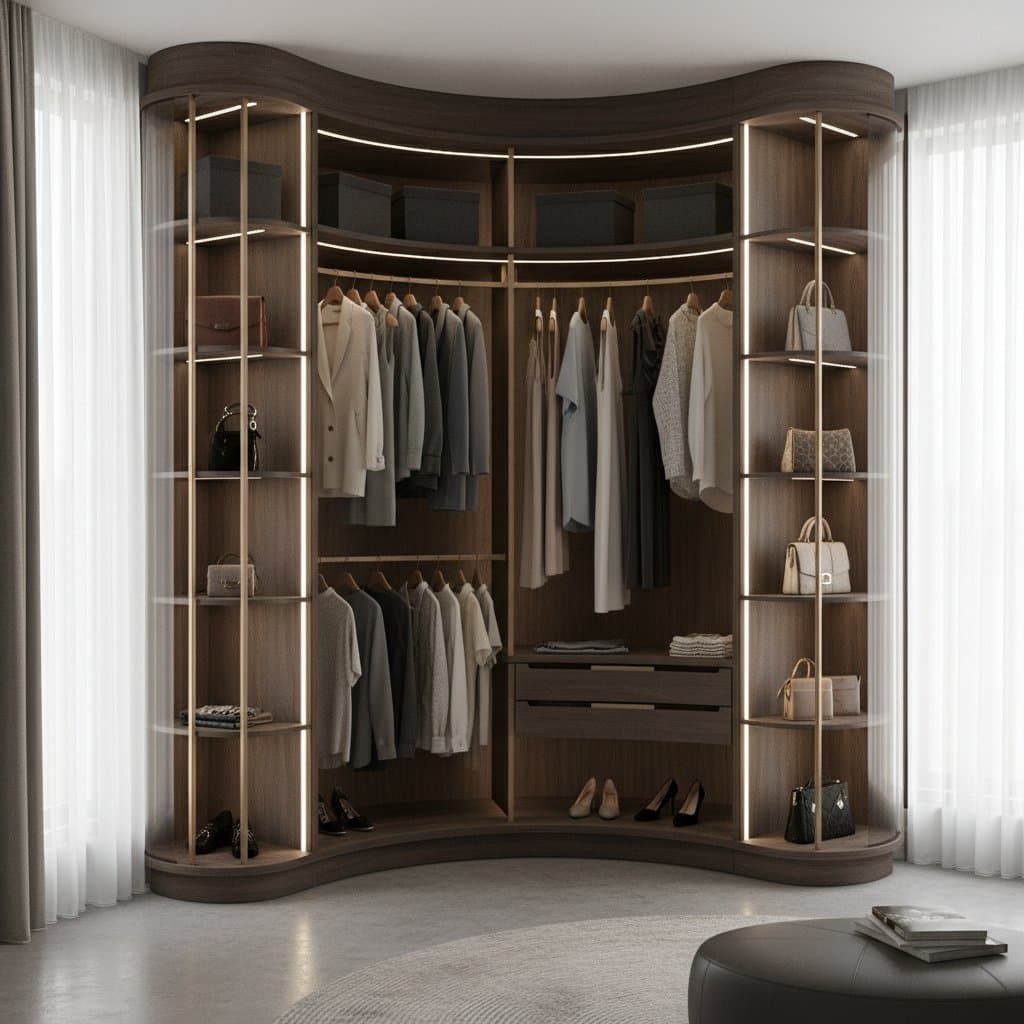Key Features of Carousel Closets
Carousel closets suit small spaces, shared wardrobes, or walk-in areas requiring enhanced organization. These systems typically occupy a footprint of 4 to 8 feet wide, or about 1.2 to 2.4 meters, based on the selected model. Homeowners choose between built-in installations for a seamless fit or freestanding options for flexibility. Costs range from approximately $500 for basic manual units to over $4,000 for advanced motorized versions.
The Mechanics of a Rotating Closet
A rotating closet carousel operates like a vertical Ferris wheel dedicated to clothing. Users turn a hand crank or activate a remote to bring garments into view through a smooth, looping motion. This design eliminates the need to stretch or search through piles.
The shift from fixed rods to a dynamic system unlocks up to 50 percent more usable space. Out-of-reach items become easily accessible at eye level. Robust motorized chain drives support the weight of heavy coats and suits, while the operation remains quiet and reliable, mimicking the ease of a retail boutique.
Designer Carla Nguyen notes, "A rotating closet redefines circulation within a compact area. It removes dead zones and shifts storage from static to interactive."
Enhancing Visibility with Lighting
Effective lighting transforms a functional carousel closet into an elegant feature. Install LED strip lights along the frame or overhead to deliver consistent illumination during rotation. Select warm white bulbs at around 3000K to ensure accurate color representation for fabrics.
Motion sensors trigger lights on demand, conserving energy and freeing hands for selection. In setups with windows or glass doors, natural light pairs well with artificial sources. Incorporate reflective elements like satin walls or mirrors to boost brightness without creating glare, ensuring every piece stands out clearly.
Optimizing Storage and Organization
Visibility defines rotating closets, yet thoughtful organization maximizes their potential. Integrate hanging areas with adjustable shelves, pull-out drawers, and dedicated spots for accessories such as shoes or handbags.
Consider these practical configurations:
- Double-level hanging rods to position shirts above pants, reducing vertical space needs.
- Pull-out trays lined with felt for secure storage of jewelry, belts, or watches.
- Vertical dividers to maintain neat stacks of folded sweaters.
- Side hooks for hanging scarves, ties, or handbags.
- Built-in hampers at the base to hide laundry efficiently.
Balance the load across the carousel for optimal performance. Place heavier coats on central or lower racks, reserving upper sections for lighter items.
Installation and Upkeep Essentials
Handy individuals tackle carousel closet installation as a weekend project, but professionals guarantee perfect leveling for fluid movement. Units arrive in modular components that pass through standard doorways.
Measure ceiling height, wall width, and depth with precision before starting. Allow at least 2 inches, or about 5 centimeters, of clearance on all sides for rotation. Provide ventilation around any motor housing, especially in wall-adjacent placements.
Upkeep requires little effort. Apply silicone spray to moving parts periodically and tighten screws as needed. Wipe tracks with a damp cloth and dust shelves routinely. For motorized units, replace belts every few years in under an hour.
Promoting Sustainability Through Design
Rotating closets blend technology with eco-conscious principles. They utilize existing areas fully, avoiding the purchase of additional furniture or major remodels. Manufacturers often employ recyclable steel and finishes with low emissions.
Better organization extends garment lifespan via improved airflow and visibility, cutting down on replacements. This approach encourages mindful wardrobes over impulsive additions.
Opt for secondhand or refurbished models to further reduce environmental impact. Adapted from commercial uses like dry cleaners or costume rooms, these pieces refresh easily with paint or new shelving for residential appeal.
Cost Considerations by Tier
Prices for rotating closets span options to fit various budgets, with long-term savings from enhanced efficiency.
Entry-level models, priced at $500 to $1,200, feature manual cranks, simple steel construction, and basic finishes. They work well for renters or tight spaces.
Mid-range selections from $1,500 to $2,500 include electric operation, built-in lighting, and tailored shelving for reliable performance.
Premium systems starting at $3,000 offer app integration, high-end materials, and bespoke elements suited to luxury dressing areas.
Integrating Seamlessly into Daily Life
Carousel closets extend beyond storage to influence home dynamics. Visible options simplify choices and streamline mornings. This setup fosters calm routines and highlights the value of intentional design in everyday spaces.
